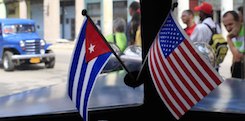WDI’s research project aims to identify the factors influencing the performance of energy enterprises in emerging markets, and provide a framework and methodology for documenting and assessing these models. The team will identify factors that relate to the technical, business, policy and socio-economic contexts that energy enterprises operate within, and compile an initial repository of energy business models using these factors as an analysis methodology. It also will look at energy enterprises in Uganda, India and Cuba leveraging existing relationships across both WDI and the Erb Institute.
Amy Gillett, vice president of WDI’s Education Initiative, visited Cuba last month to assess how the Institute could assist the country’s burgeoning entrepreneur community. She shares her experience meeting entrepreneurs on the ground.
In a first for WDI, two managers visited Cuba last month to assess how the Institute could assist the country’s burgeoning entrepreneur community.

Amy Gillett, vice president of the Education Initiative, and Diana Paez-Cook, senior program manager of the Grants Management team, were part of a 20-person delegation that traveled to the island nation in May as part of a culture and policy trip organized by the travel company Insider Expeditions. Many on the trip were lawyers, policy development professionals, and lobbyists who hoped to learn more about Cuba’s economic transition.
That transition is slowly developing in the wake of renewed diplomatic ties between Cuba and the United States, and President Barack Obama’s historic trip to Havana in March. While it still operates a largely state-controlled economic system, the Cuban government has begun to make changes by permitting more of its citizens to operate private businesses.
WDI was founded in 1992 shortly after the collapse of communism in the Soviet Union as a way to help firms and organizations in formerly closed economies transition to a more free market economy. Cuba is viewed as the last of the Soviet bloc countries to transition to a more open economy.
Over the years, WDI has provided entrepreneurship training in Morocco, Rwanda, and Bahrain, and delivered business education training workshops to thousands of managers in former Soviet bloc countries.
Paez-Cook said the visit she and Gillett made to Cuba was invaluable because of the knowledge gained about the current situation on the ground and the connections made during the visit. She said the pair has a much better understanding of Cuba, which is “its own unique universe.”
While WDI typically works in partnership with local organizations to provide entrepreneurship training and other programs, the current system in Cuba has prevented the development of an organized civil society. A traditional approach of seeking out a partnership with an NGO will therefore not be viable at this time. Instead, Paez-Cook said WDI would need to cultivate relationships with individuals, educational institutions, and other entities to find ways to engage and support the transition.
Another factor on how open Cuba becomes is the outcome of the U.S. presidential elections. The next president will have the opportunity to build on the progress made by the Obama administration and work with the successor to current Cuban president Raul Castro, who plans to step down in 2018.
Paez-Cook said WDI will explore opportunities for engagement over the next few months.
“As economic and policy changes continue in Cuba in the medium- to long-term, entrepreneurship training and technical assistance could go a long way in providing Cuban entrepreneurs with tools and techniques to sustain successful businesses,” she said. “That said, any entrepreneurship program in Cuba would have to be uniquely tailored to the current context and conditions, and leverage the amazing creativity and resourcefulness of the Cuban people. It will be important to work in partnership with Cubans every step of the way to assist with their needs and learn from them as well.”
 Gillett said she was struck by the entrepreneurial spirit among Cubans, who are very interested in potential economic opportunities. She encountered a man who had a license from the Cuban government to operate a coconut water stand. Since resources are severely limited, the vendor works with what he can find, including the coconuts he harvests from nearby trees.
Gillett said she was struck by the entrepreneurial spirit among Cubans, who are very interested in potential economic opportunities. She encountered a man who had a license from the Cuban government to operate a coconut water stand. Since resources are severely limited, the vendor works with what he can find, including the coconuts he harvests from nearby trees.
“After meeting small-scale entrepreneurs and gaining a deeper understanding of the economic situation, we’re in a great position to start developing ways to help entrepreneurs move their businesses to the next level,” she said. “The resourcefulness and can-do spirit of the entrepreneurs we met was truly impressive. We saw many examples of business owners running creative businesses despite the lack of resources and raw materials available on the island.
“I believe that further access to materials and to business training would provide a huge lift to entrepreneurs in Cuba and a much needed stimulus to the Cuban economy.”
When the Berlin Wall fell in late 1989, taking with it communism in Eastern Europe, it triggered the region’s transition from a command economy to a market one. In what seemed like an instant, the way the Soviet bloc countries had operated for decades was changing.

“Things happened quite quickly,” said Paul Clyde, president of the William Davidson Institute (WDI) at the University of Michigan, who lived in Slovakia in 1993 and served as an economic adviser to the Czech and Slovak governments. “The structure that had been in place for all those years suddenly was not there anymore. It was sudden change.”
WDI got its start in the wake of the fall of communism and its primary mission in those early years was to help countries make the economic transition through a program of instruction, faculty and student development, and research. And while the communist economic system was undergoing earth shattering changes in Eastern Europe, the aftershocks were felt all the way across the Atlantic on the island nation of Cuba. Suddenly, Cuba lost its main trading partners (82 percent of Cuban exports went to Soviet bloc countries; 85 percent of its imports came from these same countries) and the financier of annual, multi-billion dollar subsidies ($6 billion in 1989 alone). Some pundits predicted Fidel Castro would follow the lead of his Soviet counterparts and embrace a capitalist economy, but the Cuban leader instead stuck to his Cold War ways.
Now several decades later, as the frosty relations between the U.S. and Cuba begin to thaw in the wake of President Obama’s historic visit to Havana in March, experts are once again speculating on how arguably the last vestige of the old Soviet communist system will react economically. Will Cuba be like the Soviet bloc transition of the early 1990s – rapid and at times disorderly? Or more like recent examples of China and Vietnam, with an open economy but a strong central government still playing an integral part?
Clyde said when the Soviet bloc countries collapsed and a free market system was introduced, there had been no experience like it before, nothing to refer to, no guide on how to go about transitioning from a command to a market economy. For Cuba there are guideposts, though no two experiences are going to be alike, Clyde warned. China’s transition was different than the Soviet Union, which was different from Vietnam.
“But at least you have something in the same ballpark to draw on, to have some idea of how it might go,” he said. “Cuba has a number of benefits too. Like the Soviet bloc countries, Cuba has infrastructure and a well-educated population. Unlike the Soviet bloc countries Cuba is very close to the U.S. as a major trading partner. And it’s far from a landlocked country. When you look at Eastern Europe back in the early 1990s, many countries did not have trading partners next to them that were potentially beneficial. Most of their neighbors were in the same boat.”
Soon after its founding, WDI concentrated on the economic transition in Central and Eastern Europe. The Institute focused on three major efforts: delivering annual, six-week seminars for senior business leaders, entrepreneurs and government officials from countries with economies in transition; providing internships that allowed U-M students to work in Poland and the former Soviet republics; and, funding fellowships that allowed U-M scholars to engage intensively on the ground.
In May, Amy Gillett, vice president of WDI’s Education Initiative, and Diana Paez-Cook, senior program manager of the institute’s Development Consulting Services, will travel to Cuba to explore entrepreneurship training opportunities.
Gillett, who has a master’s degree in Russian and Eastern European Studies and did government and business work on the ground in the region from 1991-1997, said she sees many parallels between the economic transition in the Soviet bloc countries and Cuba.
“Many of the skills required by those in the former Soviet Union to aid in their economic transition are the same as what will be required by those in Cuba,” Gillett said.
Eric Leenson, founder and president of California-based SOL2 Economics and coordinator of the international project, “Socially Responsible Enterprise and Local Development in Cuba,” said the economic transformation there “needs to be looked at as uniquely Cuban.”
Leenson said the process of economic change began years ago and won’t be driven by recent, renewed relations with the U.S. He said Cuba began about seven years ago altering its economic structure in a number of ways, including wanting to lower the percentage of employees of state-run enterprises from 95 percent to about 55 percent. The government also wants to attract more foreign investment. But it remains steadfast that any new economic system still be centralized.
“What is being talked about is prosperous, sustainable socialism,” Leenson said. “Cuba is not giving up on socialism, so that makes it different from Eastern Europe. They want to maintain a strong state. They will not open up their economy willy nilly. The state is quite competent and is looking out for its own interests.”
Already, 13 U.S. airlines have applied to provide direct flights to Havana, and U.S.-based Starwood Hotels announced it would manage several hotels owned by the Cuban government. Beginning in May, the cruise line Carnival will set sail for Cuba, and Google wants to expand internet access in the country.
While President Barack Obama was meeting with Cuban officials in Havana in March, PayPal executives were in discussions with government officials about an online remittance service for the island, and singer Jimmy Buffett mingled with U.S. representatives on the trip about bringing his Margaritaville restaurant chain there.
Mel Levitsky, professor of international policy and practice at the University of Michigan’s Ford School of Public Policy and a former U.S. ambassador to Bulgaria and Brazil, said Cuba’s transition will be quicker if the old leadership of Raul Castro leaves (Castro said he’ll hand over the presidency in 2018) and a young generation of entrepreneurs push for change. Still, he sees a slow, 10-year transition at least.
This would be similar to the transition in Central and Eastern Europe. In fact, citizens in the former Soviet Bloc were unhappy when their countries did not have GDPs similar to the U.S. after 12 months. Most were shocked to hear it could take a generation before the economic transition would take hold.